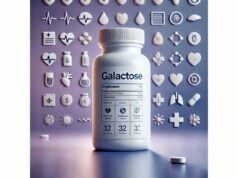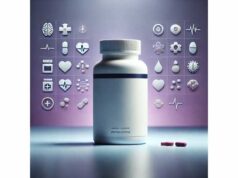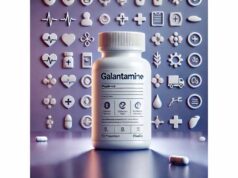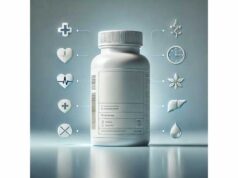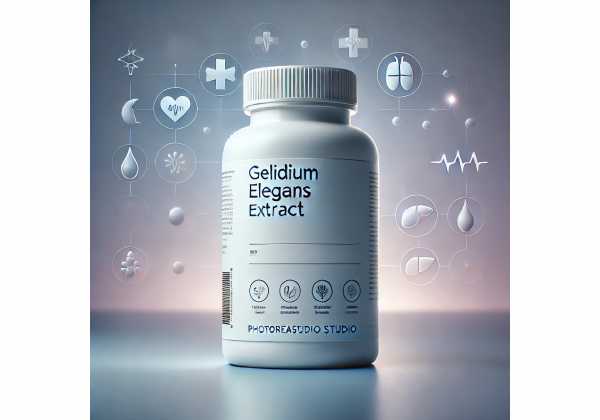
Gelidium elegans is a red seaweed long used in East Asian cuisine and now studied as a functional supplement. Its extract concentrates bioactive fibers (agarose-derived oligosaccharides), minerals, and polyphenols that may influence body weight, metabolic health, and gut comfort. Early human trials suggest standardized G. elegans extract can reduce fat mass and ease constipation-like symptoms when paired with sensible habits. Newer research also clarifies how agaro-oligosaccharides are absorbed and act as gentle prebiotics. This guide distills what matters: how Gelidium elegans extract works, who might benefit, how to use it well, and where the safety limits lie. You will find realistic expectations, evidence-based dosage ranges, and practical steps to integrate it into a routine—plus clear cautions for people who should avoid or speak with a clinician before starting.
Key Insights
- Human trials link Gelidium elegans extract to modest reductions in body fat and improvements in bowel regularity.
- Most data support 1,000 mg/day of standardized extract; neoagaro-oligosaccharides (NAOs) are often studied at 3 g/day.
- Mild gas or bloating can occur at higher fiber-like intakes; start low if your gut is sensitive.
- Avoid if you have a seaweed allergy, are pregnant or breastfeeding, or have been advised to restrict seaweed-derived products.
Table of Contents
- What is Gelidium elegans extract?
- Does it actually work for weight and metabolism?
- How to use it smartly
- How much to take (dosage)?
- Safety, side effects, and who should avoid it
- Evidence at a glance
What is Gelidium elegans extract?
Gelidium elegans is a culinary red seaweed traditionally used to make agar—a gelling agent familiar to anyone who has set a fruit jelly or looked at a petri dish. When prepared as a supplement, manufacturers concentrate specific fractions from the plant, aiming to standardize compounds that appear most responsible for health effects. The best-studied components are agaro-oligosaccharides, small chains derived from agarose. These act like fermentable fibers and may also exert direct biological activity in the gut and fat tissue.
Unlike kelp or other brown seaweeds, Gelidium is a red macroalgae. Its natural profile tends to be lower in iodine than kelps, though seaweed composition varies with species, harvest location, and processing. In addition to fiber-like fractions, Gelidium contains small amounts of polyphenols, trace minerals, and sulfated galactans. Some products are whole-extract powders; others isolate oligosaccharide fractions (frequently called neoagaro-oligosaccharides, or NAOs).
How do these components work? Three mechanisms stand out:
- Gentle prebiotic action. Agaro-oligosaccharides feed specific gut microbes. This can increase the production of short-chain fatty acids (SCFAs) such as acetate and butyrate, which help maintain gut barrier integrity and may influence appetite signaling. Human research shows low-molecular-weight agaro-oligosaccharides can permeate intestinal tissues—supporting their physiological relevance rather than passing through inertly.
- Metabolic signaling in fat tissue. Animal and cellular work suggests Gelidium fractions may activate energy-expending pathways in adipocytes and support “beige” fat function. While those are mechanistic signals, the practical question is whether they translate into better weight control in people.
- Stool normalization. Because its actives behave like soluble fibers, they increase stool water content and stimulate regularity without harsh stimulation. In trials with overweight adults, standardized extract improved bowel comfort scores compared with placebo.
Commercial products differ widely. Labels may list “Gelidium elegans extract,” “G. elegans powder,” “agar extract,” “agaro-oligosaccharides,” or “neoagaro-oligosaccharides.” If your goal is weight and metabolic support, look for a standardized extract used at 1,000 mg/day in clinical studies, or for NAOs used around 3 g/day. If your goal is gentler bowel regularity, either approach can work, but starting at the lower end is sensible for comfort.
Finally, a note on quality: choose brands that provide third-party testing and disclose standardization markers. For NAO products, it’s common to see specification to particular chain lengths (for example, DP4 and DP6). For whole extracts, look for clear daily dose instructions that align with human data.
Does it actually work for weight and metabolism?
Weight management is the most frequently asked question about Gelidium elegans extract. What can you reasonably expect?
Human outcomes so far
- Standardized Gelidium elegans extract (1,000 mg/day) has been studied for 12 weeks in overweight or obese adults. Compared with placebo, participants taking the extract experienced reductions in body fat mass and favorable shifts in body composition. Importantly, the trial tracked diet and activity to ensure changes were not simply due to lifestyle differences.
- In a separate randomized, double-blind trial with similar participants, the same 1,000 mg/day dose improved bowel symptom scores (for example, reductions in straining and perceived constipation) while maintaining good tolerability.
Agar-derived NAOs provide complementary evidence
- Neoagaro-oligosaccharides (NAOs), 3 g/day for 16 weeks, have been evaluated in overweight or obese adults. Compared with placebo, NAOs produced meaningful decreases in abdominal fat areas on CT as well as improvements in several metabolic markers. While NAOs are derived from agar (which in turn can be produced from Gelidium), they are not identical to whole Gelidium elegans extract. Still, these data reinforce a consistent story: agaro-oligosaccharide biology can translate into measurable metabolic benefits in humans.
What does this add up to?
Results point to modest but real improvements in body composition and abdominal adiposity over 12–16 weeks—particularly when paired with everyday healthy habits. The effect sizes are not “magic pill” territory: think nudges, not dramatic transformation. As with any metabolic adjunct, the best results come when you combine supplementation with steady nutrition, adequate protein, and daily movement.
Why might it help?
Two bridges connect mechanism to outcomes. First, prebiotic effects: fermented oligosaccharides can influence appetite, glycemic responses, and low-grade inflammation via SCFAs and microbial shifts. Second, direct uptake: low-molecular-weight agaro-oligosaccharides are absorbable across intestinal tissue, supporting systemic signaling beyond the lumen. Together, these provide plausible pathways for small but useful changes in body fat and waist measures.
Who seems to benefit most?
People with overweight (BMI ≥23–25 kg/m²) but not severe obesity, who are willing to maintain their baseline diet and activity or make small improvements, are closest to the studied populations. If your priority is regularity and comfort, the same extract has evidence there, too, and the doses overlap—making it uncomplicated to target both goals.
What it won’t do
It won’t override a calorie surplus, replace resistance training for muscle retention, or function like a prescription anti-obesity medication. Think of it as a supportive scaffold: helpful, but not sufficient on its own.
How to use it smartly
To get the most from Gelidium elegans extract, match the form and dose to your goal, add it to a routine you can sustain, and set expectations around measurement and comfort.
Pick the right form
- Standardized Gelidium elegans extract (GEE). Best if you want clinical continuity with trials using 1,000 mg/day. Look for products that identify Gelidium elegans specifically, not just “seaweed extract.”
- Neoagaro-oligosaccharides (NAOs). If your product is an agar-derived oligosaccharide blend standardized to shorter chain lengths (often labeled DP4/DP6), you’re using the form studied at 3 g/day. This is still consistent with the Gelidium story because agar is often produced from Gelidium species.
- Food-first options. Traditional agar-containing foods (jellies, kanten) contribute similar fibers but lack dose precision; they can complement supplements but are not a like-for-like substitute for standardized extracts.
Timing and pairing
- With meals is simplest and tends to improve GI comfort, especially when you’re new to prebiotic fibers.
- Hydration matters. Take with a full glass of water. Like other soluble fibers, agaro-oligosaccharides retain water in the gut.
- Synergy tips. Pair with protein (to support satiety) and resistance training (to bias weight change toward fat loss rather than lean mass).
How to start
- Establish your baseline. Track waist circumference (at the navel), morning weight, and—if available—body fat estimate, once per week at the same time for two weeks.
- Begin at a half-dose for 3–7 days if you’re prone to bloating (e.g., 500 mg/day GEE or ~1.5 g/day NAOs), then move to the target dose.
- Maintain a consistent routine for at least 12 weeks. The best evidence comes from 12–16-week trials.
- Monitor comfort. A little extra gas can be normal early on. Persistent discomfort means you should reduce the dose or switch form.
- Reassess monthly. Stick with objective measures: waist, weight, and stool regularity (a simple 1–5 comfort rating is fine). Decide to continue based on actual trends, not day-to-day noise.
What to combine and what to avoid
- Works well with: Whey or plant protein, creatine, omega-3s, vitamin D, and general multinutrient support.
- Be cautious combining with: Other bulk-forming fibers (e.g., high-dose inulin, psyllium) at the exact same time of day if you bloat easily. Stagger them or reduce overlapping doses.
- Medication timing: For drugs where absorption must be consistent (thyroid hormone, certain antibiotics), take supplements at a different time of day unless your clinician advises otherwise.
Budgeting and quality
- Expect standardized GEE to be more concentrated per capsule than food-grade agar. You’re paying for consistency.
- Verify third-party testing and country of manufacture; buy from a brand that updates batch numbers and expiration dates.
- If your label uses “proprietary blends,” email the company for the exact milligrams per serving and confirm whether those amounts match the research doses.
How much to take (dosage)?
Here’s what human research has used—and how to translate that into practical ranges.
Evidence-based targets
- Gelidium elegans extract (GEE): 1,000 mg/day. This is the most common dose in randomized, double-blind, placebo-controlled trials supporting fat-mass reduction and bowel symptom improvement over 12 weeks. Many products provide 500 mg per capsule, taken twice daily with meals.
- Neoagaro-oligosaccharides (NAOs): 3 g/day. In a 16-week randomized trial with overweight or obese adults, 3,000 mg/day—typically split into two doses—reduced abdominal fat areas and improved selected metabolic markers. If your supplement is specifically an NAO product (often highlighting DP4/DP6), this is the reference intake.
Choosing your starting dose
- If you prioritize metabolic support and body composition: Start at 1,000 mg/day of GEE or 3,000 mg/day of NAOs.
- If you prioritize bowel regularity and comfort: Start at 500 mg/day for 3–7 days, then increase by 250–500 mg every few days until you reach 1,000 mg/day (or 1.5 g → 3 g/day for NAOs), settling at the lowest dose that delivers steady comfort.
- Maintenance vs. active phase: You can use the trial-like dose for 12–16 weeks, then reassess whether a half-dose maintains benefits.
Context and expectations
- These doses do not replace foundational strategies (adequate protein, fiber from whole foods, activity). They’re meant to augment, not substitute.
- Give the plan at least 4 weeks before judging; most meaningful changes in trials appeared by 12–16 weeks.
Special populations
- Older adults: Begin at the lower end to minimize GI upset, and increase water intake.
- Low-FODMAP diets: Tolerance varies; consider micro-titration (e.g., 250 mg steps) and keep a brief symptom diary.
- Medication timing: Separate from drugs that require consistent empty-stomach dosing by a few hours.
What about food-grade agar or kanten?
Food gels are helpful extras but are not standardized and can vary widely in fermentability and chain lengths. If you choose them, use them as adjuncts rather than substitutes for evidence-based supplement doses.
Safety, side effects, and who should avoid it
General safety profile
Across randomized clinical trials, standardized Gelidium elegans extract at 1,000 mg/day and NAOs at 3,000 mg/day were well tolerated with adverse events comparable to placebo. Routine laboratory values (liver, kidney, hematology) remained within normal limits. The most frequent complaints were mild GI effects—gas, bloating, or looser stools—especially during the first 1–2 weeks or after abrupt dose increases.
Common, usually transient effects
- Gas or bloating as the microbiome adapts to new fermentable oligosaccharides
- Softer stools or, less commonly, transient diarrhea at higher intakes
- Early satiety (which some users consider a benefit)
Reduce the risk of discomfort
- Start low, go slow. Half-dose for several days, then step up.
- Take with meals and hydrate well.
- Avoid doubling up with other prebiotic fibers at the same time until you know your tolerance.
Who should get medical guidance first—or avoid use
- Pregnant or breastfeeding individuals. Research is lacking for these groups; defer use unless your clinician recommends it.
- People with seaweed or iodine sensitivity or any history of seaweed allergy.
- People under advice to limit seaweed-derived products (for example, due to specific endocrine or renal conditions). While Gelidium typically contains less iodine than kelp, individual products vary; check labels and follow clinical advice.
- Those with inflammatory bowel disease in active flare or severe IBS: introduce only with clinician guidance and consider lower starting doses.
- Children and adolescents: Insufficient data—avoid unless a pediatric professional suggests otherwise.
Medication considerations
- Thyroid hormone (levothyroxine): To keep absorption predictable, take your medication on an empty stomach and Gelidium products with food later in the day.
- Narrow-therapeutic-index drugs: Space dosing by a few hours to avoid nonspecific binding or delayed transit time.
Allergy and quality notes
- If you have a shellfish allergy, remember that seaweeds are not shellfish, but cross-contamination is still possible with some manufacturing lines. Choose brands that specify allergen controls.
- Select products with batch testing for heavy metals. Seaweeds can concentrate minerals from seawater; reputable suppliers screen for safety.
When used thoughtfully at studied doses, Gelidium elegans extract is generally a safe adjunct for adults looking to support regularity or nudge body composition in a healthier direction.
Evidence at a glance
Study designs and populations
- Overweight or obese adults (BMI typically 23–35 kg/m²) feature in most trials. Interventions lasted 12–16 weeks, with instructions to maintain usual diet and activity to isolate supplement effects.
- Randomization and blinding were standard, with placebo controls. Outcomes included body composition (DEXA), abdominal fat by CT, bowel symptom scales, and safety labs.
Key interventions
- GEE 1,000 mg/day (12 weeks): Demonstrated reduced body fat mass relative to placebo; supportive improvements appeared without major lifestyle changes.
- GEE 1,000 mg/day (12 weeks): Improved bowel symptom scores (e.g., less straining, softer stools within a normal range), maintaining safety.
- NAOs 3,000 mg/day (16 weeks): Reduced abdominal fat areas and shifted metabolic markers favorably compared with placebo.
Mechanistic support
- Absorption and action: Low-molecular-weight agaro-oligosaccharides permeate intestinal tissue in humans, supporting direct physiological effects.
- Microbiome interface: Prebiotic-like fermentation yields SCFAs and may modulate metabolic signaling and inflammation.
- Adipose signaling: Preclinical research shows activation of pathways involved in thermogenesis and mitochondrial function, offering a plausible bridge to the body-composition results seen in people.
What’s still uncertain
- Long-term outcomes beyond 16 weeks and maintenance strategies after discontinuation have limited data.
- Comparative effectiveness versus other fibers (inulin, glucomannan, psyllium) has not been thoroughly tested head-to-head in humans.
- Population breadth: Most studies are in East Asian cohorts; results should be replicated in diverse populations and in those with comorbidities such as diabetes or NAFLD.
Practical bottom line
- For most adults, 1,000 mg/day GEE or 3,000 mg/day NAOs is a reasonable, evidence-aligned trial. Expect subtle but meaningful shifts—not miracles—and monitor with objective measures. Combine with protein-forward eating and regular movement to multiply benefits.
References
- Anti-obesity effect of Neoagaro-oligosaccharides with overweight and obese subjects: a 16-week, randomized, double-blind, placebo-controlled clinical trial 2023 (RCT)
- Permeation of low-molecular-weight agaro-oligosaccharides across intestinal cells and tissues 2023
- Novel Therapeutic Approach for Obesity: Seaweeds as an Alternative Medicine with the Latest Conventional Therapy 2024 (Systematic Review)
- Effects of Gelidium elegans on Weight and Fat Mass in Overweight or Obese Adults: A Randomized Controlled Trial 2019 (RCT)
- Efficacy and safety of Gelidium elegans intake on bowel symptoms in obese adults: a 12-week randomized double-blind placebo-controlled trial 2019 (RCT)
Disclaimer
This article is for general education and is not a substitute for professional medical advice, diagnosis, or treatment. Always talk with a qualified healthcare professional before starting any new supplement, especially if you have a medical condition, take prescription medications, are pregnant, or are breastfeeding.
If you found this helpful, please consider sharing it on Facebook, X (formerly Twitter), or your favorite platform, and follow our social channels. Your support helps us continue creating accurate, useful health guides.



